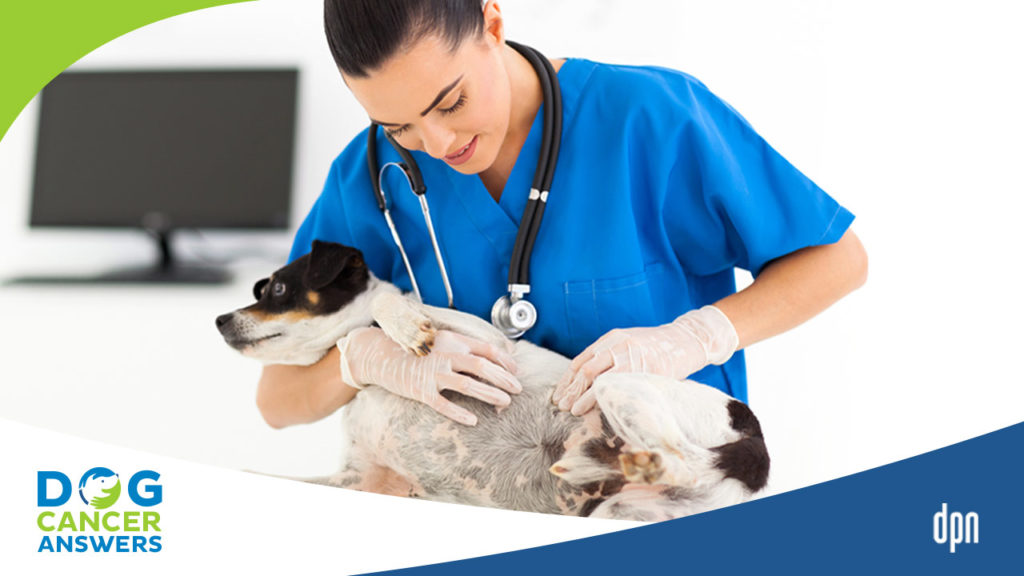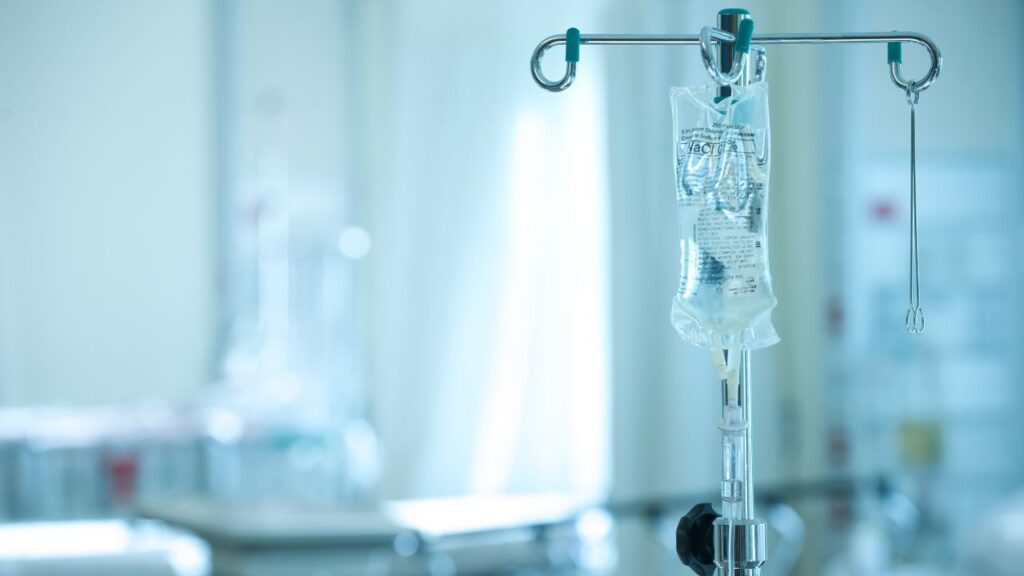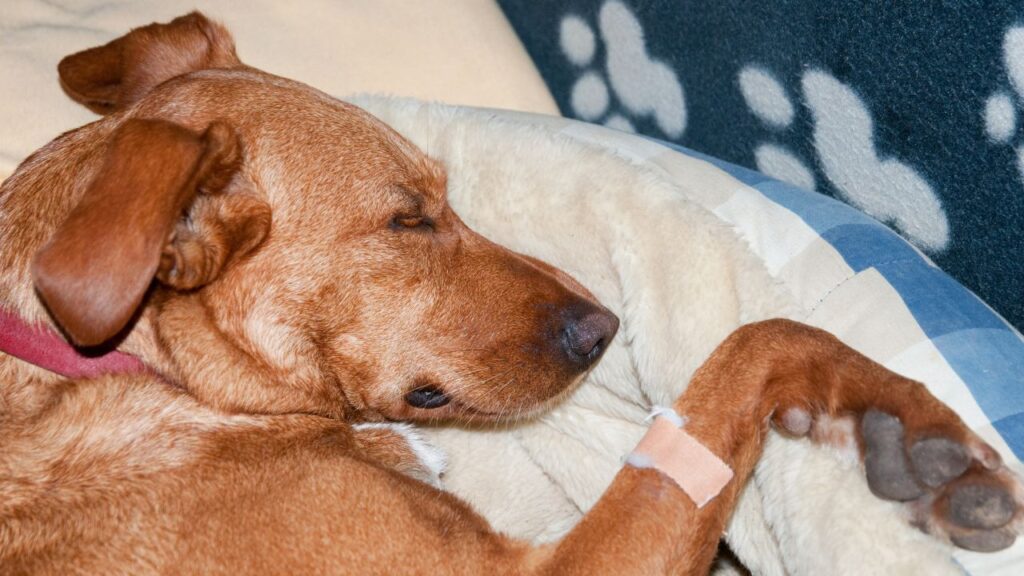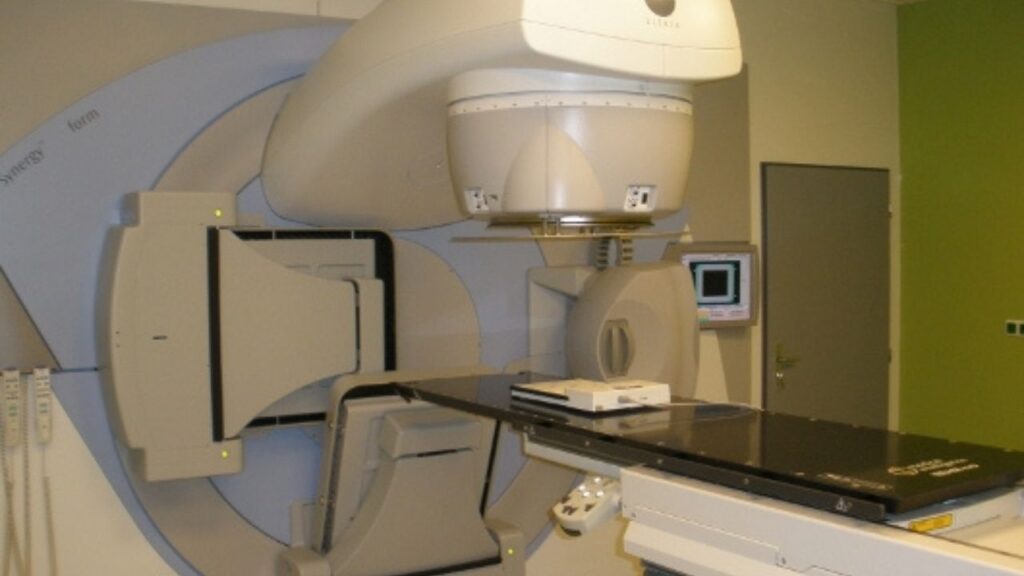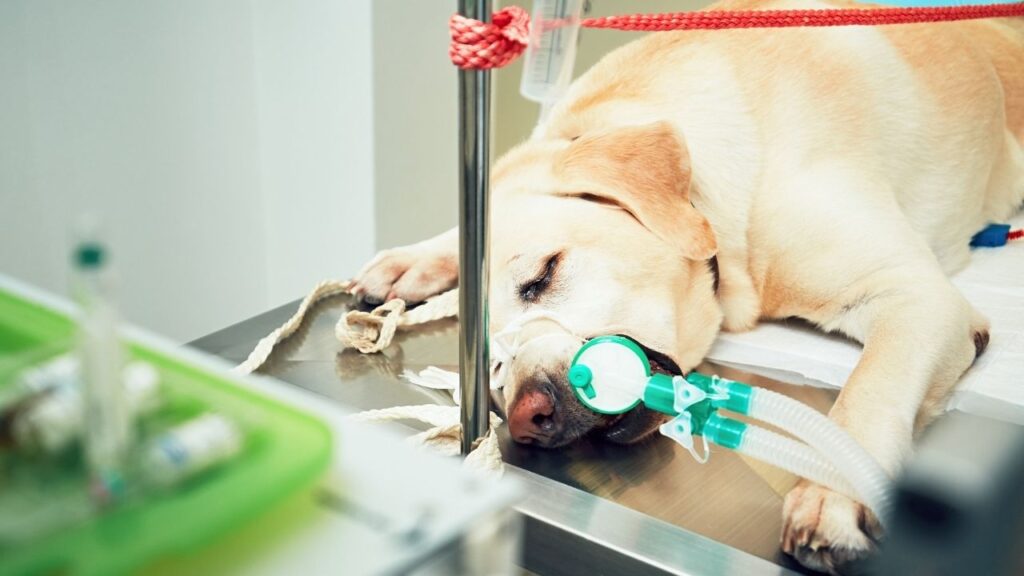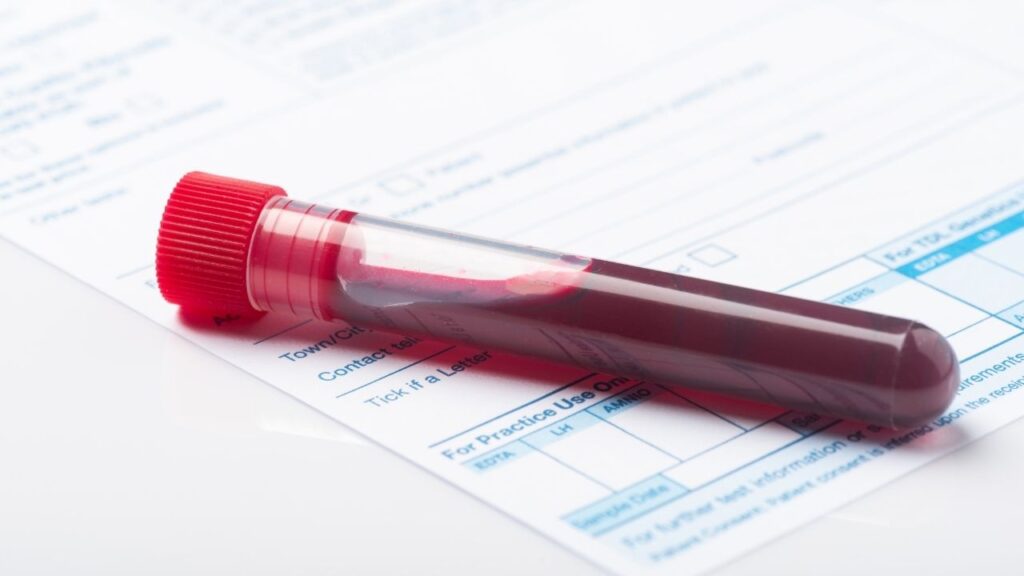The bone marrow transplant for dogs, also known as Hematopoietic Stem Cell Transplantation, is a time and labor intensive and expensive procedure, but 30-40% of treated dogs are completely cured (live > 2 years) of lymphoma. Some dogs have lived more than five years after going through the process.
Key Takeaways
- Bone marrow transplant in dogs costs upwards of $26,000 just for the procedure itself.
- Bone marrow transplants in dogs are not 100% successful, though they do offer a chance of a complete cure. B-cell lymphoma has a 30-40% success rate, and T-cell lymphoma has a 15-20% success rate.
- Common side effects of bone marrow transplants include vomiting, diarrhea, infections, and anemia. Death is also possible.
What Happens During a Bone Marrow Transplant for Dogs
The bone marrow transplant for dogs process is similar to the one a human undergoes and in fact, dogs were used to develop the human treatment.4
Before a bone marrow transplant can be started, your dog must be in clinical remission with no signs of cancer. This usually means going through a standard chemotherapy protocol, such as CHOP.
After stable remission is achieved, the transplant process can go forward. Ideally, your dog will also have DNA-based blood tests run to verify that he is in molecular remission, which means that there are no detectable cancer cells.1,2,7
Here are the steps included in a bone marrow transplant procedure:
- Contact a facility that offers bone marrow transplants for dogs and make an appointment. Transplants can be done using your dog’s own bone marrow (autologous transplant), but if you would like to use donor cells (allogenic transplant), start the process of finding a matched donor as soon as possible.
- “Conditioning,” “pre-conditioning,” or “consolidation” is a two-week course of the oral chemotherapy drug cyclophosphamide to further eradicate circulating cancer cells that remain in the body after chemotherapy. Dosage and frequency can vary – some protocols give lower doses daily, while others call for a single high dose.
- Five days before the transplant procedure, your dog will be admitted to the hospital. Each day he will receive an injection of the medication Neupogen, which encourages stem cells to be released from the bone marrow into the bloodstream.
- Apheresis day is when the stem cells are collected from your dog’s blood via a specialized machine. The process is similar to dialysis. Your dog will have catheters in place to allow blood to flow out and through the apheresis machine, which harvests the stem cells. The rest of the blood returns to your dog. The process usually takes four to five hours. In most cases your dog will be sedated or anesthetized to keep him still and calm.
Note: If you are doing a transplant using stem cells from a donor dog, the donor dog will undergo apheresis, not the patient. - On radiation day(s), your dog is put under anesthesia and receives total body radiation to hopefully kill all remaining cancer cells wherever they might be hiding in the body. Radiation kills rapidly dividing cells, which means that the bone marrow and GI tract are also affected.
- Immediately following total body irradiation, the stem cells that were collected on apheresis day are given back to your dog via an intravenous catheter. This transfusion takes about half an hour. The stem cells make their way to the bone marrow, where they repopulate the destroyed cells and start making red and white blood cells.
- While the stem cells are rebuilding the bone marrow, your dog will be hospitalized and monitored closely to address any side effects and to prevent infection. When her white blood cell count drops critically low, she will go into an isolation ward to protect her from infectious diseases that other patients in the hospital might have. Most dogs are in isolation for 2-4 days, still receiving constant monitoring and care.
- When the CBC blood values return to normal, your dog is ready to go home.
The average total hospital stay for a bone marrow transplant from start to finish is three weeks.
This intense treatment is not the right fit for every dog, but can have a happy ending. Bone marrow transplant expert Dr. Steven Suter explains the procedure in this episode of Dog Cancer Answers.
Common Types of Bone Marrow Transplants
There are two types of bone marrow transplants for dogs: an autologous transplant and an allogenic transplant.
Autologous transplant – when the dog’s own stem cells are used. The dog must be in clinical remission (ideally molecular remission) to minimize the risk of collecting cancer cells along with the stem cells.
Allogenic transplant – a donor dog’s stem cells are used. The plus to an allogenic transplant is that you know the stem cells being used to repopulate the bone marrow are cancer-free, but finding a donor can be difficult. For this to work, the donor must be a match for the patient. Matching is done via genotyping at the Fred Hutchinson Cancer Center in Washington just like for humans.7 The process takes a couple weeks. Close relatives to your dog are most likely to be a match, but it is not a guarantee. It can take months to find a match.
When a Bone Marrow Transplant is Recommended
Bone marrow transplants in dogs are most appropriate for:
- B-cell lymphoma9
- T-cell lymphoma8
- Leukemia – requires an allogenic transplant due to the difficulty of getting a clean collection of stem cells from the patient. Unfortunately, this cancer is typically extremely aggressive, so finding a match quickly enough can be a challenge.
- Young dogs7
- Dogs in stable remission
It is important to remember that no treatment is guaranteed to succeed. While bone marrow transplants do provide a chance of a cure, some dogs can also relapse after treatment. These dogs can still go on to have additional chemotherapy as needed to regain remission.
How a Canine Bone Marrow Transplant Works
Bone marrow transplants work by killing any cancer cells in the body with radiation, and then replacing the damaged bone marrow with healthy stem cells. A bone marrow transplant can result in a complete cure from lymphoma or leukemia, meaning that the dog lives over two years without any relapse.
- 30-40% cure rate for B-cell lymphoma9
- 15-20% cure rate for T-cell lymphoma8
Most studies done so far have been done with autologous transplants that use the patient’s own stem cells. Allogenic transplants are likely to have better cure rates, but not enough of them have been done to have accurate statistics at this time. This is because of the difficulty of finding a donor dog that is a match.7
Dog Cancers That Commonly Use Bone Marrow Transplants
- B-cell lymphoma
- T-cell lymphoma
- Leukemia – requires an allogenic transplant, can be difficult to find a matched donor dog quickly enough.7
How to Get the Best Results
If you are considering a bone marrow transplant for your dog, here are some things you can do to help prepare your dog:
- If there is any possibility that you might do a bone marrow transplant with your dog, start looking for a donor dog immediately. If you start the matching process when your dog starts his first round of chemotherapy, you can hopefully eliminate delays later in the process.
- Your dog must be in remission before doing the transplant.
- Crate train your dog so he is comfortable hanging out in a kennel and won’t panic while hospitalized.
- Discontinue antioxidants and artemisinin beforehand – these supplements can interfere with chemo and radiation.
- Give your dog a thorough grooming just before the transplant, including a bath if needed. This ensures that the veterinary staff don’t have to worry too much about coat care while your dog is hospitalized (most facilities will trim nails while the dog is under anesthesia, often for free).
- Keep your dog away from dog parks and unknown dogs leading up to the procedure to minimize health risks. A healthy dog at the start is more likely to come through smoothly.
Radiation therapy plays a key role in bone marrow transplants as well as being a standalone cancer treatment. Vet tech specialist Jenny Fisher covers all the ins and outs of radiation in this episode of Dog Cancer Answers.
Home Care
Your dog will be released from the hospital once his blood values have returned to normal or near-normal after the bone marrow transplant. Aftercare at this point is typically minimal, but there may be some special considerations for your pup:
- May need skin protection from sun depending on hair loss
- May have temporary activity/travel restrictions to minimize the risk of infection
- May be on antibiotics to resolve infection or other medications to alleviate side effects
Follow Up
According to Dr. Steven Suter of North Carolina State University, your dog will need to have her complete blood count (CBC) rechecked once or twice a week until everything is back to normal values. This can take about four weeks, with platelets being the stragglers for most dogs.
Once the CBC is back to normal, general guidelines for follow-up monitoring is to do a physical examination with your vet once a month for six months to check lymph node size. No bloodwork is needed at these appointments. After the first six months, exams can be decreased to every three months until two years post-transplant.1,2
Follow-up care can be done with your regular veterinarian or your local oncologist if you live far away from the facility that did the bone marrow transplant.
When to Not Use a Bone Marrow Transplant
Bone marrow transplants are not appropriate for every dog with cancer.1,2,7
These dogs often are not a good fit for this procedure:
- Really old dogs – they may not have enough natural lifespan left to be worth the expense and/or putting the dog through the intensity of the process.
- Highly anxious dogs – the dog will be in the hospital 2-3 weeks total, which can be very hard on some dogs even with constant veterinary care.
- Cancers other than lymphoma or leukemia.
- Dogs at high risk of anesthesia complications.
- Dogs with organ failure, diabetes, Cushings, or other diseases which increase the risk of infection.
Where to Get a Bone Marrow Transplant for Dogs
Bone marrow transplants for dogs are currently only available at Bellingham Veterinary in Bellingham, WA. North Carolina State University in Raleigh, NC has a program, but is currently reviewing its data.5
However, as the veterinary field is constantly changing, potential locations may change. Information should be available through your local oncologist.
Why so few locations? This is because doing a bone marrow transplant safely requires a large amount of specialized (and expensive) equipment, plus the ability to provide 24-hour care and monitoring for the patients.
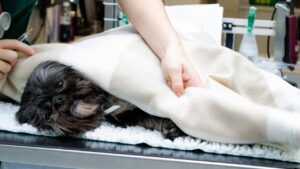
Bone marrow transplants require expensive equipment and specially trained staff to provide round-the-clock care for your dog.
Safety and Side Effects
While bone marrow transplants can result in a total cure, they do come with risk for a variety of side effects including death.
Side effects can occur due to the medications used, radiation, anesthesia, immune system rejection of an allogenic transplant, or secondary infections. Here are some specific side effects and safety concerns to keep in mind when deciding if this treatment is right for you and your dog.
- Total body irradiation kills the bone marrow, white blood cells, and platelets, leaving your dog vulnerable to infection or bleeding until the transplant takes hold. It takes time to recover normal values after the transplant.3
- Doing apheresis on small dogs can be difficult. Small dogs have successfully received bone marrow transplants, but this must be done with caution.6,7
- Vomiting and diarrhea often occur after total body radiation. These are usually mild and can be managed with medications in the hospital.1,2,7
- Hair loss in breeds such as Poodles, Shih Tzu, Bichons Frise, or Poodle mixes.7
- Anemia – some dogs may require blood transfusions.1,2,7
- Cystitis (irritation of the bladder) in rare cases after cyclophosphamide administration.1,2
- Emboli (blood clots) to the brain or lungs in rare cases. 1,2
- Death – more likely if the dog is in poor health at the start of the procedure. Safety has improved dramatically as protocols have been refined over time. 1,2,7
Death can occur due to anesthesia complications, radiation complications, rejection of the transplant (more likely with an allogenic transplant, especially if proper matching wasn’t done), or infection before the dog’s bone marrow and white blood cells have recovered.
Stringent safety protocols to protect the dog from exposure to infections, aggressive treatment of any possible infections with antibiotics, and refinement of radiation doses over time all work together to make this treatment as safe as possible, but there will always be potential risks to consider.
Radiation burns are unlikely with total body irradiation because the radiation dose is spread over the entire body rather than being focused on a single area.
Give yourself grace if you can’t afford expensive treatments for your dog’s cancer. That is Dr. Barrow’s top advice in this episode of Dog Cancer Answers.
Bone Marrow Transplant for Dogs Cost
In 2022, the current average cost of a bone marrow transplant at North Carolina State University was about $26,000 USD.7
In addition, the cost of chemotherapy to put the dog in remission before pursuing a bone marrow transplant can be up to $10,000 or more depending on the protocol chosen.
Follow-up care is thankfully on the less expensive side, with periodic CBC bloodwork costing $100 on average and recheck physical exams typically being $45-60 at your regular vet’s office. Exact costs will vary by region and hospital.
Obviously, this is a very steep price tag, which can make bone marrow transplants impractical or impossible for many dog lovers.
Many pet health insurance plans do cover bone marrow transplants. However, your dog must be covered by a plan before being diagnosed with cancer, or the company will consider his cancer to be a preexisting condition and will not cover the cost of treatment. Review plans carefully to determine what deductible you will need to pay and if there are any annual or lifetime caps.
Visit our Stress and Finances section for additional information on how to cover dog cancer treatment costs.
- A reference guide for bone marrow transplant – Bellingham, WA. Bellingham Veterinary. https://bhamvet.com/news/bone-marrow-extended/ Published October 15, 2019. Accessed March 2, 2023.
- Bone Marrow Transplantation: An owner’s guide – pet cancer center. Pet Cancer Center. http://www.petcancercenter.org/files/VCA_West_LA_Animal_Hospital_BMT_OWNERS_GUIDE.pdf. Published March 2010. Accessed March 2, 2023.
- Escobar C, Grindem C, Neel JA, Suter SE. Hematologic changes after total body irradiation and autologous transplantation of hematopoietic peripheral blood progenitor cells in dogs with lymphoma. Veterinary Pathology. 2011;49(2):341-343. doi:10.1177/0300985811410721
- Lupu M, Storb R. Five Decades of progress in haematopoietic cell transplantation based on the preclinical canine model. Veterinary and Comparative Oncology. 2007;5(1):14-30. doi:10.1111/j.1476-5829.2006.00114.x
- Medical oncology: Bone marrow transplant. Veterinary Hospital. https://hospital.cvm.ncsu.edu/services/small-animals/cancer-oncology/oncology/bone-marrow-transplant/. Accessed March 2, 2023.
- Sekiguchi T, Vigani A, Ripoll AZ, Taylor S, Culler C, Suter SE. Clinical application of apheresis in very small dogs weighing <8 kg to pediatric patients. Therapeutic Apheresis and Dialysis. 2019;24(3):333-342. doi:10.1111/1744-9987.13432
- Sutter S. Podcast 163: Bone Marrow Transplant for Dogs. https://www.dogcancer.com/podcast/diagnosis-and-medical-procedures/bone-marrow-transplants-for-dogs-dr-steven-suter/ April 2022.
- Warry E, Willcox J, Suter S. Autologous peripheral blood hematopoietic cell transplantation in dogs with T-cell lymphoma. Journal of Veterinary Internal Medicine. 2014;28(2):529-537. doi:10.1111/jvim.12302
- Willcox JL, Pruitt A, Suter SE. Autologous peripheral blood hematopoietic cell transplantation in dogs with B-cell lymphoma. Journal of Veterinary Internal Medicine. 2012;26(5):1155-1163. doi:10.1111/j.1939-1676.2012.00980.x
Topics
Did You Find This Helpful? Share It with Your Pack!
Use the buttons to share what you learned on social media, download a PDF, print this out, or email it to your veterinarian.


